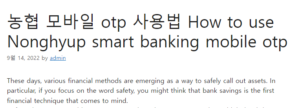These days, various financial methods are emerging as a way to safely call out assets. In particular, if you focus on the word safety, you might think that bank savings is the first financial technique that comes to mind.
In fact, due to repeated interest rate cuts since the 2000s, I sometimes think that it is not an option that shows excellent efficiency as a financial technique for asset growth.
However, the majority of people still use bank savings as a safe haven or as a way to store unused income for consumption.
Thanks to such a large number of people using banks, various types of banking transaction systems have been introduced for customer convenience. A typical example is mobile banking, which is the most commonly used these days. 농협 모바일 otp 사용법
Since it is an Internet-based service, I wonder if it can be classified as Internet Banking? Because of the high degree of freedom of use, I also use mobile banking for most of my banking operations. 이베이스매뉴얼
Recently, I tried Nonghyup mobile banking without visiting the bank for personal work. Did you know that in the case of a transaction exceeding a certain amount, the transaction continues after verifying the transaction using a high-level security medium such as a security card or otp? 🙂

In the past, I used a hardware device to authenticate the transaction by receiving a new password every moment, but as I used it, I had a number of problems such as battery problems and not knowing, so I canceled it and recently used a method using a security card and a public certificate There was.
However, this time, the public certificate was abolished and a problem occurred when it was changed to a joint certificate. Since this banking business was not a small transaction, I proceeded to confirm the transaction through a secure medium without any doubt. Strangely, instead of the security card input screen, a screen asking to enter the canceled OTP number appeared, which made me very embarrassed.
The problem did not end there. I was forced to enter the One Time Password, and despite the fact that I entered the password delivered in real time using the OTP device I was using, the transaction failed repeatedly. As I found out, I was told to enter the Nonghyup mobile OTP authentication number, not the password using the OTP device.
Since the transaction had to proceed unconditionally, I recklessly received a new Nonghyup mobile OTP number and used it. Although I was embarrassed, I was able to make a transaction safely because I was able to obtain a non-face-to-face issuance with one smartphone and one ID card without visiting a separate bank branch, so I thought it was a service focused on user convenience.
How to issue?
Issuing is very easy. After running the Nonghyup Banking application, click the More button at the top right to activate the hidden menu. At this time, click the Authentication/Security tab and finally click Mobile OTP Issuance/Reissuance in the OTP menu that appears. Then, if you select non-face-to-face issuance, you will be taken to a screen where you can enter personal information such as social security number and account number.
After entering the account you want to use and verifying your identity through a mobile or joint certificate for non-face-to-face issuance, ID verification takes place. it becomes Of course, it will be possible to transact on a PC using mobile authentication as well.
What are the advantages?
The biggest feature of the service is that, unlike the commonly known hardware method, it is easy to make large transactions with just one smartphone without a separate medium. And it boasts high ease of use because the process of receiving a new password every time is omitted and transactions are possible by entering the password entered at the time of registration.
But at this point, I can only ask one question. Because the same password is used every time, there is a contradiction to the point of thinking that the use of the word One Time Password is useless. At this point, I think, shouldn’t the name be changed to Everytime instead of Onetime?
However, since there is only one password that appears on the outside, and a different password is recorded each time it is actually used on the software, it still adheres to the name of One Time. What makes this possible is that the Nonghyup mobile otp number is issued and can be used only on one registered smartphone.
However, the method chosen to achieve such ease of use and security comes at a disadvantage as well. This is because, even if you use the same contact number, if you change your smartphone, the previously registered Nonghyup Mobile OTP cannot be used. Of course, you can re-register as many times as you want using non-face-to-face, but it is also true that the hassle cannot be avoided.
This is an authentication method that clearly reveals the pros and cons, but rather than the hassle of re-registration, the fact that there is no verification process through a separate device or card for each transaction is the part that I feel more satisfied with personally, but it will vary depending on the user’s personal preference. Was it the same? 🙂
So far, we have learned about Nonghyup mobile otp. Even if you usually use a different transaction authentication method, you can easily issue a new or reissue with a smartphone and one ID card, so I think it will be quite helpful to know the registration method and the pros and cons in advance.